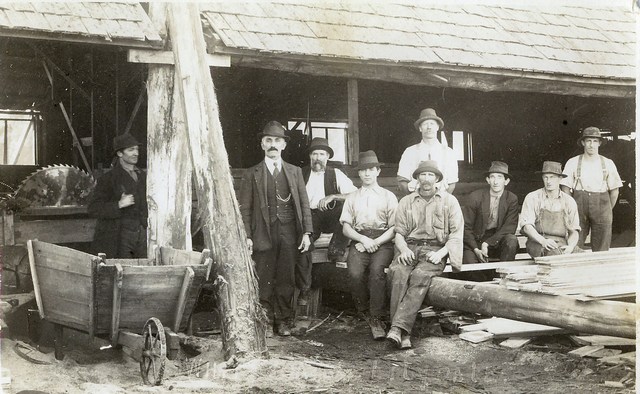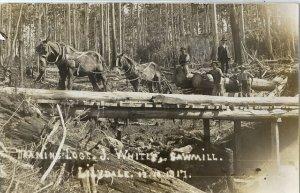This article taken from MacFarlane's History of the North East published by the North Eastern Advertiser 2007
The Lilydale District
(Further notes on Scottsdale Railway and Other Matters)
(
A Launceston friend who has been reading the recently published articles on the building of the
“Mr. Bardenhagen, of Lilydale, had the contract to supply the sleepers for the line, and Mr. Fred Boland was paymaster. 6/- a 12 hour day being the rate. A common advertisement in the daily paper at the time was:
“Wanted, two good hammer and drill men”.
No doubt these would be required for work on the cuttings. But the workmen would not have had much spare time for recreation in a 12 hour day! Times have changed indeed!
Lilydale District
It is time for us now to go across and have a look at the Lilydale area of the North East.
Invariably, when the name of a town or place of geographical interest is mentioned, someone wants to know the origin of the name. In the case of Lilydale, enquiries have the choice of several answers to the question.
Mr. W. Wilson, Council Clerk of the
(1) the name of Lilydale was changed from Upper Piper by the Road Trust
(2) the name was changed to Lilydale at a public meeting
(3) Two Justices of the Peace were responsible for the change
(4) Mr. J. Crompton suggested the change to the Postal Department owing to the similarity in the names of Upper Piper and Lower Piper
(5) Mrs. J.G. Mather, wife of the Presbyterian Minister, suggested the name owing to the number of wild lilies growing in the district.
Mr. Wilson states that the only definite information available at the time of writing is a notice published in the Hobart Gazette on
“It is hereby notified for public information the the Post Office at Upper Piper’s River will in future by known as Lilydale. By His Excellency’s Command, B. Stafford Bird”.
…………………..Reference to Walsh’s Almanac for 1883 shows a post office at Piper’s River was then in the Police District of George Town with C. Adams in charge, and there was a public school at Upper Piper’s River with Mr. Martin Cheek as teacher. Lilydale is not mentioned.
In 1888, Lilydale appears among the post offices in the Police District of Selby, postmaster G. Sulzberger, but the school is still shown as at Upper Piper’s River, although with a different teacher, Mrs. Mary Rees.
Turning to the Almanac of the following year, we discover that the
Some Lilydale Pioneers
(
Just how some of the roving military or other members of the settlement at
Governer Lachlan Macquarie, on his inspection of Launceston and George Town, in 1821, would undoubtedly have been delighted had there been time to ride out along the Piper with his cavalcade and mark out prospective town sites here and there which would go down into his journal as ‘so named by me’.
Bit it was left to other pioneers with Scottish blood in their veins, of whom one was James Scott, to traverse paths of future name-board fixing.
According to the Cyclopedia of Australia one of those who settled very early in the Lilydale district was John Campbell, who came to the Colony in 1855. Before settling in Lilydale he had been engaged by David Taylor, at Winton.
Another in the line of pioneers was W. Somerville, who also travelled out from
Loone, in his Tasmania’s North East, says that the date of John Campbell’s arrival was 1860, and that just a little before that, in 1859, Michael Shea had taken up his abode as the first settler in the Lilydale district.
Other early settlers were John Power, Jacob Sulzberger, J.J. Marx, A. Dollery,
Pioneering Days
…………………..Loone reminds us of various aspects of life in the pioneering days of Lilydale. “When the first settlers arrived,” he says, “the bush was full of all kinds of Tasmanian animals, such as kangaroos, wallabies and native birds – jays and parrots – which were often welcomed as good food for the early settlers.
“As soon as the selectors could cut down and burn off, and sow down with grass seed enough land to keep one or two cows, and a few fowls, the pioneer carried his products upon his back along the bush track into Launceston and sold them, as there was no cart road in the forest in those early days”.
……………a picture of the household equipment of the slab huts – a camp oven, a couple of billies and a frying pan, with tin plates and mugs, iron knives, forks and spoons, and kerosene tins to serve as boilers and containers; and we see the men in flannel shirts, moleskin trousers and heavy boots, tramping through the bush in their work of bringing the land into submission and reproduction.
…….It was in 1860 that the first sawmill to be erected on this part of the coast was put up on the bank of the Piper, at Underwood. According to Loone, it was driven by water power, and was the project of an American firm. It was later sold to Messrs. Grubb and Tyson.

……………………A tramway from the mill joined the
